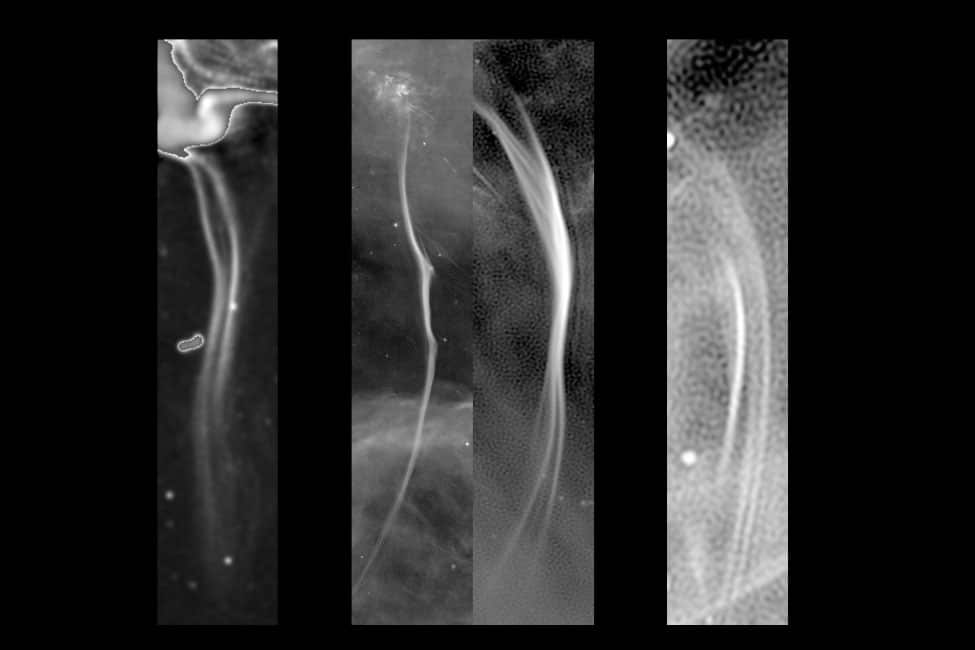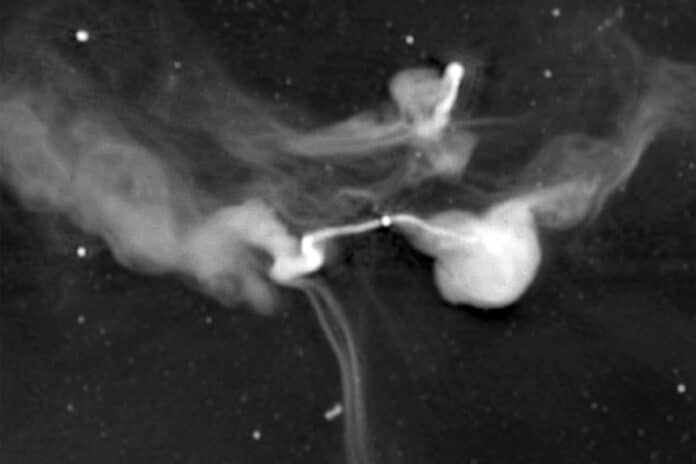Magnetized radio filaments are abundant in our galaxy’s inner few hundred parsecs. Progress in understanding this population of filaments has been slow over the last few decades, in part due to a lack of detection elsewhere in the galaxy or external galaxies.
Now, 40 years later, Northwestern University astrophysicists have, for the first time, introduced two possible explanations for the filaments’ unknown origins. They proposed that the filaments might result from an interaction between large-scale Wind and clouds or could arise from turbulence inside a weak magnetic field.
The first filaments that Zadeh found towered close to the Milky Way’s centre supermassive black hole and were up to 150 light-years long. Zadeh increased his observational database by over 1,000 filaments earlier this year. The one-dimensional filaments in that batch occur in groups and pairs, frequently evenly spaced, stacked side by side like harp strings, or pouring sideways like individual ripples in a cascade.
Zadeh revealed the mysterious filaments are made up of cosmic ray electrons that are whirling along a magnetic field almost as quickly as light. Zadeh continued to wonder where the filaments came from despite having solved the mystery of what the filaments were comprised of. As a result of the discovery of a brand-new population outside of our galaxy, astronomers now have more opportunities to study the physical processes around the filaments.
He said, “After studying filaments in our own Galactic Center for all these years, I was extremely excited to see these tremendously beautiful structures. Because we found these filaments elsewhere in the universe, it hints that something universal is happening.”
The new population of filaments resembles the filaments in our Milky Way in appearance, but there are some significant distinctions. For instance, the filaments outside the Milky Way are substantially larger and range from 100 to 10,000 times longer. They also have lesser magnetic fields and are much older. Most of them oddly dangle at a 90° angle from a black hole’s jets into the immense void of the intracluster medium or the region tucked between the cluster’s galaxies.

However, the newly found population shares the same length-to-width ratio as the filaments of the Milky Way. And it appears that the same methods are used by both groups to transmit energy. The electrons in the filaments are more energetic closer to the jet, but as they descend further, they become less energetic. The seed particles required to form a filament may be provided by the black hole’s jet, but an unknown force must be driving these particles along astounding distances.
Zadeh said, “Some of them have great length, up to 200 kiloparsecs. That is about four or five times bigger than our entire Milky Way. What’s remarkable is that their electrons stay together on such a long scale. If an electron traveled at the speed of light along the filament’s length, it would take it 700,000 years. And they don’t travel at the speed of light.”
Scientists theorized that “The filaments’ origins could be a simple interaction between galactic Wind and an obstacle, such as a cloud. As the Wind wraps around the obstacle, it creates a comet-like tail behind it.”
Zadeh explained, “Wind comes from the galaxy’s motion as it rotates. It’s like when you stick your hand out the window of a moving car. There’s no wind outside, but you feel the air moving. When the galaxy moves, it creates Wind that could be pushing through places where the cosmic ray particles are fairly loose. It sweeps the material and creates a filamentary structure.”
“As radio galaxies move around, gravity can affect the medium and stir it. The medium then forms spots of swirling eddies. After the weak magnetic field wraps around these eddies, it can get stretched, folded, and amplified — eventually becoming elongated filaments with a strong magnetic field.”
“All of these filaments outside our galaxy are very old. They are almost from a different era of our universe and yet signaling the Milky Way inhabitants that a common origin exists for the formation of the filaments. I think this is remarkable.”
Journal Reference:
- F. Yusef-Zadeh, R. G. Arendt, M. Wardle. Populations of Magnetized Filaments in the Intracluster Medium and the Galactic Center. The Astrophysical Journal Letters. DOI 10.3847/2041-8213/ac982a
